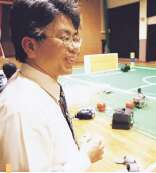
Associate Professor
Department of Intelligent
Machinary and Systems,
Faculty of Engineering
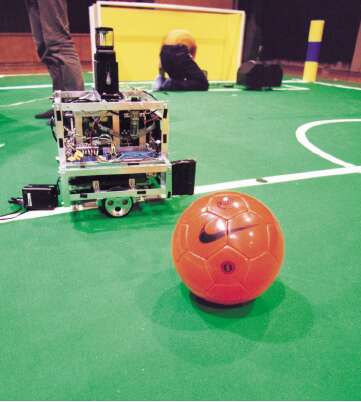
On June 19 through June 25, 2002, "RoboCup 2002 Fukuoka/Busan" will be held at the Fukuoka Dome and other venues. It is an international competition where soccer games are played by robots. Kyushu University RoboCup team kindly accepted this interview in their spare moments during their final adjustment for the competition.
Q: You have only two months left before the competition. What kind of work will you focus on?Aiming to develop "a team of fully autonomous humanoid robots that can win against the human world champion team" by 2050, this RoboCup project started in 1995. Today, more than 3,000 researchers from 35 countries and regions are participating in various projects such as international games, conferences, research and educational programs.
A: Our main emphasis is on finishing up the software that makes the robots move smoothly. We program the motion of the robots. Then by applying the program to the robots, we test if they move as we expected, and if they can perform well at the competition. After the test, we work towards improving the performances. Through competitions like Japan Open, the 5th RoboCup international competition at Seattle last year, and a competition at Tokyo this year, we have been able to collect the data of our team and also other teams. Now we know the advantages and disadvantages of our robots and also other teams' robots.
 |
Motoji Yamamoto Associate Professor Department of Intelligent Machinary and Systems, Faculty of Engineering |
A: I would say Osaka University and Keio University are the strongest teams in Japan. This spring, our team was comprehensively beaten by Keio University. Other than Japanese teams, Albert-Ludwigs-Universitat Freiburg (Germany), the winner of the 5th RoboCup international competition, and GMD (German National Research Center for Information Technology), which is allied with Kyushu Institute of Technology, are strong. Before the competition, I would like to have a practice match with them.
 Q: It seems The robots of Kyushu University team flip the ball rather than kick. Do the other teams have the same kind of movement? Do they have robots that can do header shots?
Q: It seems The robots of Kyushu University team flip the ball rather than kick. Do the other teams have the same kind of movement? Do they have robots that can do header shots?
A: There are rules for the robots and the way to shoot is basically the same for all the teams. The appearance of the robots with their covers on are alike, however, under the covers, the mechanisms are different. Our robots kick the ball using aircylinders, on the other hand, some other robots are operated using motors or electricity. Most of the parts in our robots are hand-made, but some teams modify ready-made machines for their robots.Q: To play a soccer game, the robots need complex movements. It must be incredibly hard to give the robots such ability.
A: The basic movement of the robot is to find the ball, catch and dribble it, and then make a shot. Another important movement is placement. All the robots that are teammates communicate with each other all the time to obtain a picture of their positions and, at the same time, recognize the positions of the opponents. Sometimes all the teammates move synchronously. Since the function of the goalkeeper strongly affects the results of the game, it should be programmed to react promptly. As you can see, students are struggling with the programming. However, it is an interesting thing to move an object using a computer. It is a very interesting thing to program something you imagined in your head and actuate it through physical movement of a robot.
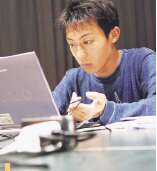 |
Akira Motomura 1st year, Graduate School of Information Science and Electrical Engineering |
A: Sure it is.Q: Which part are you in charge of?
A: Since I was a senior student in the Department of Electrical Engineering and Computer Science, I have been programming software for operating the robots. Each robot has a program for its movement and the total data of the programs are huge.Q: Does a robot actually see what is happening in the game field?
A: Yes. There is a camera on the robot's head. The robot recognizes the opponents through image processing of the data received by the camera. Concentrating on the program making, it took me about one and a half months to evade opponents. It was tough work, however I was very impressed when the robot moved as I expected. To make it move is still difficult and I have been working on improving the program.Q: You must be looking forward to the competition?
A: Recently, I have been preparing for the competition every day, all the time. Since it will be held at Fukuoka, I feel the pressure of local people's expectations. I want to do my best.
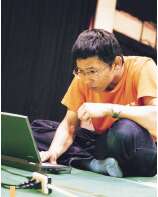 |
Motoki Kato 1st year, Graduate School of Engineering |
A: I am in charge of the goalkeeper.Q: It is a very important role, isn't it?
A: Yes. Basically, the goalkeeper blocks the balls on its front. However, it is difficult to protect the goal when a ball is thrown from outside of the field. The robot needs to recognize its own position on the field precisely through self-position identification.Q: Do you watch real soccer games to research how to improve the movement of the robot?
A: Because I like soccer very much, I don't watch games just for research. If I could concentrate only on making the robot, it would be fun, and not very hard. I am making efforts to strike a good balance between schoolwork and this robot project.
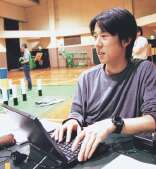 |
Kouhei Inomata 1st year, Graduate School of Electrical Engineering, Fukuoka University |
A: My supervisor in Fukuoka University is Associate Professor Matsuoka who is an alumnus of Kyushu University. He introduced this project to me, and I felt it would be interesting even though I would have to spend a lot of time on it. I come here three times a week, in the afternoon after my research at my university. Even when I don't come here, I do something for this project every day.Q: Which part are you in charge of? Does it have anything to do with your specialty?
A: I am in charge of making the program that shows the movements of all the robots on a computer screen. Each robot is shown by a dot on the computer screen, and I am trying to add the direction of each robot. It is difficult and I still have a long road to travel. When I was an undergraduate student, I studied programming. What I am doing in this project is not directly associated with my specialty, however I would like to pursue a career so I can fully use of this experience in the future.
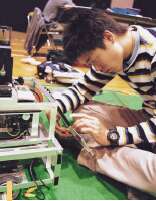 |
Hiroyuki Yasuda 2nd year, Graduate School of Engineering |
A: Yes, I am. Now I am making a new robot. The robot should be strong enough to protect the computer inside from any crash impact. If the computer short-circuits and shuts down, it takes quite some time to set up the program again. Since we won't have time to repair the program during the game, we will have to exchange it with another robot. Four robots including the goalkeeper play in a game, and I am building two more stand-by robots. We don't have enough people and time so I have to do many things simultaneously. I feel that it is difficult to separate the hardware from the software when we build a robot.
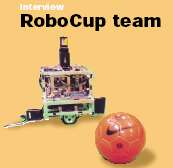 |
| Kyushu University RoboCup teamfs web site |
| http://mari.is.kyushu-u.ac.jp/~fusion/ |
A: I started to work on this project last December. At first, I thought building those robots was beyond my knowledge, however, once I became engaged in the project, I found that robots are built using the existing technology, which is not special. The difficult part is to move them in the way we want, which requires various kinds of knowledge. In this project, I can apply what I learnt and that is really practical.
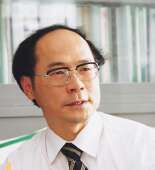 |
Tsutomu Hasegawa Professor, Department of Intelligent System, Faculty of Information Science and Electrical Engineering |
A: During New Year's holiday in 2000, some students who were intending to remain at the university to continue their research after finishing their doctor courses started to talk about a RoboCup project. I talked to Dr. Yamamoto and we decided to build small-sized robots. We also asked Dr. Matsuoka, Associate Professor of Fukuoka University to help this project. We made a presentation of the robot in July 2000 at an event held in Fukuoka. In August in the same year, Hitachi Information & Control System, Inc. (HICOS) offered to work together with us on the robots. They said this project would help their engineer to study the application of their vision system. Thanks to their help, we decided to build more complicated middle-sized robots. In February 2001, the first machine was completed, and at about the same time, it was decided that this RoboCup international competition would be held in Fukuoka and it became our goal.Q: I heard you have participated in several competitions so far.
A: Last May, we entered the Japan Open held in Fukuoka. We were confident, however, we didn't have enough knowledge to compete in a game. Our robots didn't move as we expected and we were beaten completely. The defeat spurred us on and that August at an international competition in Seattle, we were able to receive a satisfactory result.Q: How many people are involved in this project?
A: Besides myself, Associate Professors Yamamoto, and Matsuoka (Fukuoka University), three assistants of Kyushu University, four or five students who constantly join, and one young computer engineer from HICOS are involved. Dr. Yamamoto and I are both specialized in intelligent robots. He is in charge of designing the robots, developing movable parts and controls, and I am in charge of software.Q: How much does it cost to build a robot?
A: In addition to building a robot, it needs to be repaired and improved. In total, we have spent more than \1,000,000 for one robot. Although only four robots play soccer on the field, we have to make stand-by robots in case of a problem. The cost is covered by HICOS's research fund, Kyushu University's fund and assistance from *P&P.*P&P: Kyushu University's grant for faculties to promote research and education, which started in 1997.
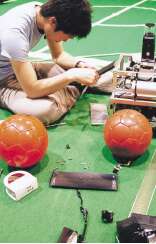 Q: How do you rate this project from an educational perspective?
Q: How do you rate this project from an educational perspective?
A: Most of the senior students who are assigned to this laboratory don't know anything about robots at first. While building the robot, they can understand its mechanism in detail, and gain practical knowledge in both hardware and software. In addition, they can compete against people from all over the world with the robot they built. Their efforts are directly reflected in the robot. It is exciting. Actually, students come to the laboratory everyday without spending their time on part-time jobs. I would say it is a great project for education. I would like to find a research theme through the project.Q: How do you rate the possibility of winning?
A: At the Japan Open, we made it into the top 3. This time, the competition will be held in Fukuoka and Busan, which is favorable to us. We would like to beat the other two teams, Keio University and Osaka University. As far as foreign teams are concerned, they are making strong efforts for this robot project. In some countries, a company and its engineers, rather than students, run this project. They have ample funds. It might be difficult to compete with those teams.